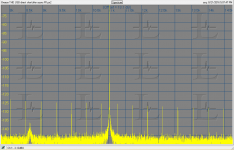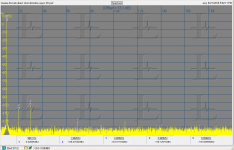NwAvGuy: ODAC Released
Nwavguy owned a DAC-1 and compared ODAC to it and claims they are equally transparent.
Okay. So far so good. But, here are the specs for a Lynx2: Product Information
I have compared a Lynx2 and a DAC-1 and they sure sound different to me. Don't know about the ODAC, but would be interested to try it.
Yes, and I would think that the major hangup would be correct modelling of a speaker. As far as I know there are no sim models for speakers that come remotely close to the accuracy of the C and L and even active device models. In that sense, sims of passive xovers are pretty useless except for a very, very rough proof of concept.
Jan
Yes. And though using actual measured Z of the speakers being used is another closer step .... the speaker Z has little connection (other than resonance freq) to the speakers acoustic output (FR). It is only the acoustic response that is important in the cross-over design. The better SIM would take in the passive components variation (L change a lot vs freq)) as well as speaker Z and frequency/phase response of the drivers.
THx-RNMarsh
Last edited:
There never can be too little switching artifacts in an audio circuit. The A/D conversion process is fraught with unending baggage of SH cap dielectric absorption, switching time speed and bounce, clock jitter. It goes on and on. Then there is the dac. Then the gymnastics to interface with the analog world.... The Rube Goldberg comic strip of audio.
Okay. So far so good. But, here are the specs for a Lynx2: Product Information
I have compared a Lynx2 and a DAC-1 and they sure sound different to me. Don't know about the ODAC, but would be interested to try it.
ODAC is cheap enough to just get for many. At least with ODAC and all benchmark product fairly complete measurements are available to compare and decide if a reduction of a bit of fluff 130dB down would enhance listening please.
ODAC is cheap enough to just get for many. At least with ODAC and all benchmark product fairly complete measurements are available to compare and decide if a reduction of a bit of fluff 130dB down would enhance listening please.
Again, I don't think many audio professionals in the music industry buy DACs primarily based on specs. For most people and most purposes, any differences between a ODAC and DAC-2 may be completely negligible. But some people are not using always DACs for listening pleasure. For some it is work, and hard work at that. At times there may be a need to ignore the music and focus attention on distortion, HF smear, and other artifacts that are subtle, but that you know the mastering engineer and a few other people are likely to hear. If someone has never tried to mix a record to a professional level of quality, it may be hard to understand just how hard it is, how much focused effort and attention it takes, and how little subtle decisions can affect the finished product. When trying to do that type of thing to very best of one's ability, the differences between a DAC-2 and an ODAC may be very apparent.
There never can be too little switching artifacts in an audio circuit. The A/D conversion process is fraught with unending baggage of SH cap dielectric absorption, switching time speed and bounce, clock jitter. It goes on and on. Then there is the dac. Then the gymnastics to interface with the analog world.... The Rube Goldberg comic strip of audio.
And all these horrors somehow become invisible when you measure these units. It's like magic.
Both.Built from scratch stuff, or in commercial products?
I did not import filters, the chip has options for different filter slopes. Those can be changed if you want. Loading your own would be interesting, for sure. Now I understand why you were talking about rePhase.And how have you imported filters, what chipset permits that, none I know of until fairly recently?
And all these horrors somehow become invisible when you measure these units. It's like magic.
Here is one explanation for some of that: https://benchmarkmedia.com/blogs/ap...pll-in-your-d-a-can-taint-a-b-listening-tests
The Wall of Sound in German Fidelity magazine.
So John, you obviously passed the 'test'
BTW -- when I changed from DAC1 to DAC2 after some years of listening to the DAC1. yes, there is an easily detectable difference. The DAC2 is better, overall. Wish it had more inputs, though.
Benchmark of course claim that both are 'transparent' and only give 2 cases where a DAC2 'might' be better. Two thumbs up for their honesty there.
From what little I know specs is the last thing audio professionals worry about with some of their choices. Impressing clients possibly comes way higher, which may drive the choice of some labels. *Again, I don't think many audio professionals in the music industry buy DACs primarily based on specs.
If someone has never tried to mix a record to a professional level of quality, it may be hard to understand just how hard it is, how much focused effort and attention it takes, and how little subtle decisions can affect the finished product. When trying to do that type of thing to very best of one's ability, the differences between a DAC-2 and an ODAC may be very apparent.
I thought we were discussing DIY here? Of course professionals won't buy DIY stuff. However it must be soul destroying for those professionals who need absolute SOTA in a DAC when the finished product is compressed to buggery in mastering.
*Recording Studios | London | AIR Studios is a perfect example (to me) of catering to a diverse client base and their whims.
Perfect sound FOREVER!And all these horrors somehow become invisible when you measure these units. It's like magic.

I understand your points, but I don't think a DIYer could design and develop a top quality state of the art DAC for only the cost of a bag of components. As a practical matter, one would need a well equipped lab with state of the art test equipment. By the time all is said and done, the DIY cost of design and development and testing something equivalent to a DAC-2 would probably be much more than just going out and buying one.
If I am wrong and some DIYer can design a DAC of that caliber for cheap, then by all means publish it here and everyone will have good cause to be very happy.
Well, others have answered this but -- if you think you need test kit you don't have, rent it. But then, I also think any correctly engineered DAC with an appropriate spec for the job spec will sound the same, if you don't peek.
There's no magic, just engineering.
Here is one explanation for some of that: https://benchmarkmedia.com/blogs/ap...pll-in-your-d-a-can-taint-a-b-listening-tests
Nothing there about the measurements.
Benchmark of course claim that both are 'transparent' and only give 2 cases where a DAC2 'might' be better. Two thumbs up for their honesty there.
There's a whole bunch of that sort of thing in the Benchmark Application Notes collection. To me, they are a rare example of high end audio done right. Of course I still can't afford any of their stuff, but hey. ¯\_(ツ)_/¯
-- Jim
You do not need to spend much to get SOTA USB DAC performance. These measurements are from a $60 USB DAC Xmos U8 DAC AK4490 Top Asynchronous USB Decoder Support Headphone Output | eBay With two mods- a 12V DC supply and swapped the socketed opamp for an LME49720. Not much of a challenge.
More could be had if someone wanted to make new firmware to support additional features supported by the AK4490.
(Both at 44.1 KHz sample rate and the distortion is possibly limited by the Emu 1616M.)
More could be had if someone wanted to make new firmware to support additional features supported by the AK4490.
(Both at 44.1 KHz sample rate and the distortion is possibly limited by the Emu 1616M.)
Attachments
yes, there is an easily detectable difference.
THx-RNMarsh
We're back here, is this stuff subtle and you need care to hear it or do you have to be deaf not to hear it? It can't be both ways. The NWAVGUY has been doing his thing for a while and has listened to a lot of stuff so to him the difference is nil. For me there's a big cloudy sea of overlap on difference preference issues and these discussions are doomed to go no where.
I have to bail on this stuff, I couldn't tell the difference between an ordinary decent sound card and an ESS9018 reference design on 24/96 Hi-Res downloads and good headphones. So all that remains is let's do it together just like there are no great wines only great bottles of wine there is no substitute for sharing exactly the same experience.
Nothing stopped an argument faster than when a well known rather obnoxious wine collector and a certain wine importer sat down to dinner and the collector donated a bottle (IIRC Shrieking Eagle itself) and the wine importer said yes this is **** in my opinion (but in much more elaborate words to that effect). I had the same experience on a lesser scale with Flowers Zinfandel brought by a true believer, high alcohol evil swill and much to my pleasure oxidized noticeably in less than 30min.
Last edited:
- Status
- Not open for further replies.
- Home
- Member Areas
- The Lounge
- John Curl's Blowtorch preamplifier part II

